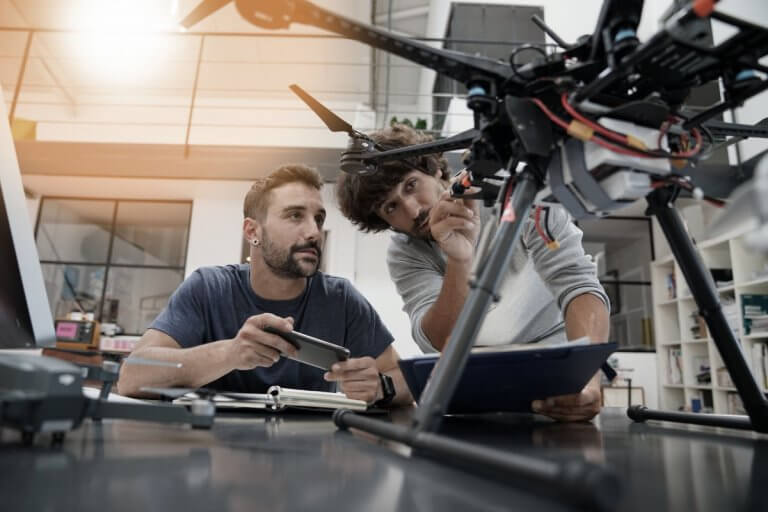
As J. Felipe Ruiz watched the Parker Solar Probe launch from Florida’s Cape Canaveral Air Force Station on August 12, he felt like a nervous father dropping his firstborn off at college.
That’s because Ruiz was part of the team that spent four years designing, building, and testing the probe’s crucial heat shield and solar array cooling system.
These components will ultimately allow the probe to orbit within four million miles of the sun’s surface without burning up, collecting ground-breaking data on solar winds, the physics of stars, and more along the way.
Ruiz is a mechanical engineer with the Johns Hopkins University Applied Physics Laboratory’s (APL) Space Exploration Sector. He is also a master’s degree candidate in space systems engineering for the Whiting School’s Engineering for Professionals (EP) program, from which he will graduate in May.
He had originally planned to attend graduate school immediately after completing his bachelor’s in mechanical engineering at the University of Texas at Austin. Then APL called. It’s hard to turn down an offer to come and build a spacecraft, he says.
Studying at EP has allowed Ruiz to embrace both dreams.
“[The program’s] flexibility allows me to do what I need to do for my job and still take classes,” he explains of his evening and weekend course schedule, with classes taken both in person and online.
“When I was in Florida, I did my homework and talked to my class group to keep our projects going. My classes tie back to my work, so I get to implement what I am learning the next day at work. EP has given me all the tools I need to build my solution from scratch.”

Source: Shutterstock
A new, lower-cost prosthesis
Three years ago, when Bill Haris, MS ’16, first walked into his human-robotics interaction class, he never would have guessed that this moment would set him on the path to his current US Navy position.
The course was designed by Bob Armiger, MS ’06, and Jeff Lesho, MS ’89, PhD ’03, both of the APL, as a way of connecting master’s students with the duo’s cutting-edge work on the Revolutionizing Prosthetics project with the Defense Advanced Research Projects Agency.
“When they showed us what they were doing with their prosthetic limb program, I approached both instructors and said, ‘How can I get into this?’” recalls Haris, who then embarked on an independent study project that lasted two semesters.
Haris quickly learned from Armiger and Lesho that in the world of prosthetics, there are two extremes.
On one end, there are thought-controlled, highly-dexterous devices that are very expensive to produce. On the other, there are prosthetic limbs printed using 3D technology. These are a lot cheaper to create but are also less responsive.
“Bill’s project was really about connecting the two dots,” says Armiger, “meaning, how can we take some of the lessons learned from the advanced prosthetics [program] and bring them to the very low-cost prosthetics field to improve the quality?”
After collaborating with Armiger, Lesho, and others at APL, Haris settled on a way to bridge that gap.
Using open-source technology, he figured out advancements like pattern recognition, wireless control, machine learning, and multidigit actuation into upper-extremity prostheses for a fraction of the price.
Haris’s advanced 3D printed prototypes, for example, cost US$500 or less to produce. Comparable devices not created using a 3D printer might cost tens of thousands of dollars.
The open-source component is critical, not only in creating more affordable prostheses but also in giving scientists a toolkit — an “instructional guide,” notes Armiger — to continually make improvements.
Haris presented his project at the American Academy of Orthotists and Prosthetists 43rd Academy Annual Meeting and Scientific Symposium in March this year.

Source: Shutterstock
Whiting School of Engineering – A hotbed of success
Haris and Ruiz represent just two prime examples of the school’s resounding student triumph.
This is a school designed for trailblazers, drawing on the fundamentals of maths, science and creativity to provide a transformative education for some of the most elite, intellectually-driven graduates in the field.
The Whiting School of Engineering (WSE) strives to supply an “outstanding engineering education that is innovative, rigorous, and relevant, and that prepares its graduates to be 21st century leaders”.
By blending first-rate teaching practice with a passion for exploration, this school consistently advances the discipline’s knowledge frontier.
Follow Whiting School of Engineering on Facebook, Twitter, YouTube, Google+, Instagram and LinkedIn
Liked this? Then you’ll love…
Johns Hopkins Engineering graduates deliver inspired innovations
Study Engineering Online: Virtual Labs at Johns Hopkins University







